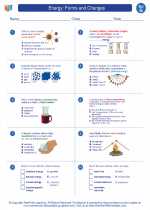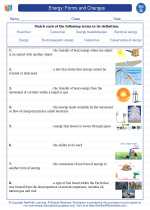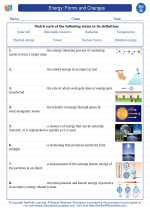Energy: Forms and Changes -> wavelength
Wavelength
Wavelength is a fundamental concept in the study of waves. In physics, a wave is a disturbance that travels through space and time, transferring energy from one point to another. The wavelength of a wave is the distance between two consecutive points on the wave that are in phase, or have the same point in their cycle. It is usually denoted by the Greek letter lambda (λ).
Types of Waves
There are various types of waves, including:
- Electromagnetic Waves: These include radio waves, microwaves, infrared, visible light, ultraviolet, X-rays, and gamma rays. They do not require a medium to travel through and can travel through a vacuum.
- Mechanical Waves: These waves require a medium, such as air, water, or solids, to propagate. Examples include sound waves and seismic waves.
Calculating Wavelength
The wavelength of a wave can be calculated using the formula:
\[ \lambda = \frac{v}{f} \]Where:
- λ = wavelength (in meters)
- v = velocity of the wave (in meters per second)
- f = frequency of the wave (in hertz)
Properties of Wavelength
Some important properties of wavelength include:
- Relation to Frequency: Wavelength and frequency are inversely proportional. As the frequency of a wave increases, its wavelength decreases, and vice versa.
- Relation to Wave Speed: Wavelength is also inversely proportional to the speed of the wave. If the speed of the wave increases, the wavelength decreases, and vice versa.
- Relation to Energy: In the case of electromagnetic waves, the energy of the wave is inversely proportional to its wavelength. This means that waves with shorter wavelengths have higher energy, while waves with longer wavelengths have lower energy.
Study Guide for Wavelength
Key Concepts
- Definition of wavelength
- Types of waves
- Calculating wavelength
- Properties of wavelength
Practice Questions
- What is the definition of wavelength?
- Give examples of electromagnetic and mechanical waves.
- How is wavelength calculated?
- Explain the relationship between wavelength and frequency.
- How does the energy of an electromagnetic wave relate to its wavelength?
Additional Resources
- Wavelength and Frequency Interactive Simulation
- Wavelength Calculation Worksheet
- Online Quiz on Wavelength and Waves
I hope this study guide helps you understand the concept of wavelength better! If you have any more questions, feel free to ask.
.◂Science Worksheets and Study Guides Seventh Grade. Energy: Forms and Changes
Worksheet/Answer key Energy: Forms and Changes
Energy: Forms and Changes  Worksheet/Answer key
Worksheet/Answer key Energy: Forms and Changes
Energy: Forms and Changes  Worksheet/Answer key
Worksheet/Answer key Energy: Forms and Changes
Energy: Forms and Changes  Vocabulary/Answer key
Vocabulary/Answer key Energy: Forms and Changes
Energy: Forms and Changes  Vocabulary/Answer key
Vocabulary/Answer key Energy: Forms and Changes
Energy: Forms and Changes  Vocabulary/Answer key
Vocabulary/Answer key Energy: Forms and Changes
Energy: Forms and Changes 

 Worksheet/Answer key
Worksheet/Answer key
 Worksheet/Answer key
Worksheet/Answer key
 Vocabulary/Answer key
Vocabulary/Answer key
 Vocabulary/Answer key
Vocabulary/Answer key
 Vocabulary/Answer key
Vocabulary/Answer key

The resources above cover the following skills:
Skills and Processes: Students will demonstrate the thinking and acting inherent in the practice of science.
Constructing Knowledge: Design, analyze, or carry out simple investigations and formulate appropriate conclusions based on data obtained or provided.
Use mathematics to interpret and communicate data.